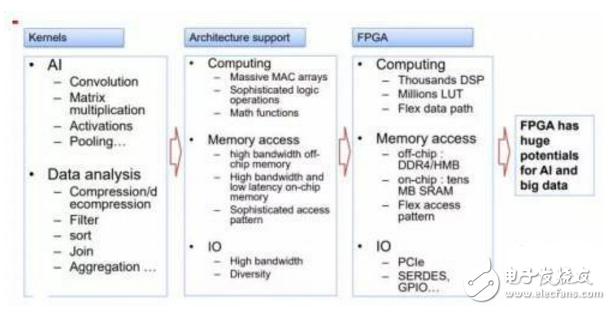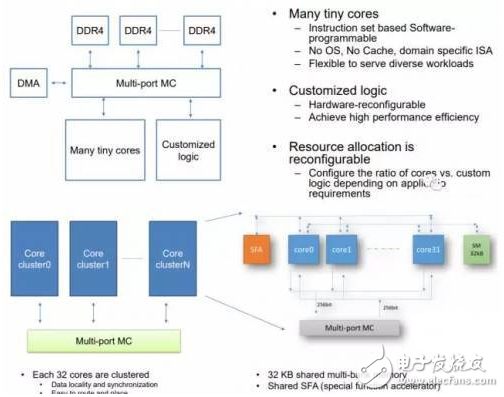Recently, at the Hot Chips conference in California, Baidu unveiled the XPU, a 256-core FPGA-based cloud computing acceleration chip developed in collaboration with Xilinx. This marked one of the first detailed public presentations of the chip's architecture. Baidu has been making significant progress in deep learning, particularly using GPU-based systems. However, the company is now exploring new options to enhance performance and efficiency, leading to the development of the XPU.

Baidu explains the situation of AI and data analysis workloads on FPGA
Baidu researcher Ouyang Jian explained that the XPU was designed with diversity in mind, focusing on computationally intensive and rule-based tasks while ensuring high efficiency, performance, and flexibility. At the Hot Chips conference, he presented the XPU alongside Xilinx, highlighting its potential in handling complex computing workloads.
The XPU aims to strike a balance between performance and efficiency, especially for diverse computing tasks. While FPGAs are excellent for specific applications, their complexity and lack of programmability can be a challenge. In contrast, CPUs offer flexibility, and GPUs excel in parallel processing. The XPU combines the best of these worlds, targeting compute-heavy, rule-based tasks with CPU-like adaptability.
Currently, one of the main challenges with XPU is its limited programmability. Unlike traditional processors, it doesn’t have a compiler yet. Ouyang Jian mentioned that the team is working on developing one, which will make the chip more accessible to developers.
To support tasks like matrix operations and convolutions, XPU features high-bandwidth memory interfaces, including DDR4 and HBM, along with on-chip SRAM for low-latency access. The DSP units within the FPGA provide parallel processing capabilities, enhancing overall performance.
In microbenchmark tests, the XPU showed efficiency comparable to x86 cores for memory-intensive, conventional computing tasks. For tasks requiring data synchronization, scalability still needs improvement. However, for non-synchronized tasks, the XPU scales linearly with the number of cores.
One of the key limitations remains the lack of a compiler, forcing developers to use assembly language and manage execution through the host system. Tasks must be split, coded, and executed via custom logic functions on Linux. This process is still quite involved and not as user-friendly as traditional programming environments.

The XPU features 256 cores operating at 600MHz, with shared memory for efficient data synchronization across all cores. Ouyang Jian emphasized that Baidu has long used FPGAs in its data centers, cloud platforms, and autonomous driving projects. Based on this experience, the company aimed to build a more versatile and powerful solution with the XPU.
Last year, reports emerged about Baidu’s SQL accelerator based on its deep learning SDA. According to Ouyang Jian, the XPU shares similar advantages in terms of memory bandwidth and latency, thanks to its SA architecture.
Although the benchmark results shown were limited, this was the first time Baidu publicly demonstrated the XPU. If the chip proves effective in AI, data analytics, cloud computing, and autonomous driving, Baidu may consider transitioning from FPGA to ASIC technology for future iterations.
Vertical Light Tower
A vertical light tower is a tall structure that is designed to provide high-intensity lighting for various purposes. It typically consists of a vertical pole or mast with multiple light fixtures mounted at different heights. The tower is usually made of durable materials such as steel or aluminum to withstand harsh weather conditions.
Vertical light towers are commonly used in construction sites, outdoor events, sports fields, and emergency situations where temporary lighting is required. They provide bright and uniform illumination over a large area, making them ideal for nighttime operations or areas with limited natural light.
These towers are often portable and can be easily transported and set up at different locations. They may have adjustable heights and angles to direct the light where it is needed most. Some models also come with additional features such as telescopic masts, generators, and remote control systems for convenient operation.
Vertical light towers can be powered by various sources such as electricity, diesel, or solar energy. They are designed to be energy-efficient, minimizing power consumption while providing maximum brightness. Some models also incorporate advanced technologies such as LED lights, which offer longer lifespan and lower maintenance requirements compared to traditional lighting options.
Overall, vertical light towers are essential tools for illuminating large areas and ensuring safety and productivity in various industries and applications.
Vertical Light Tower,Stadium Light Towers,Led Light Towers,Emergency Light Towers
Grandwatt Electric Corp. , https://www.grandwattelectric.com